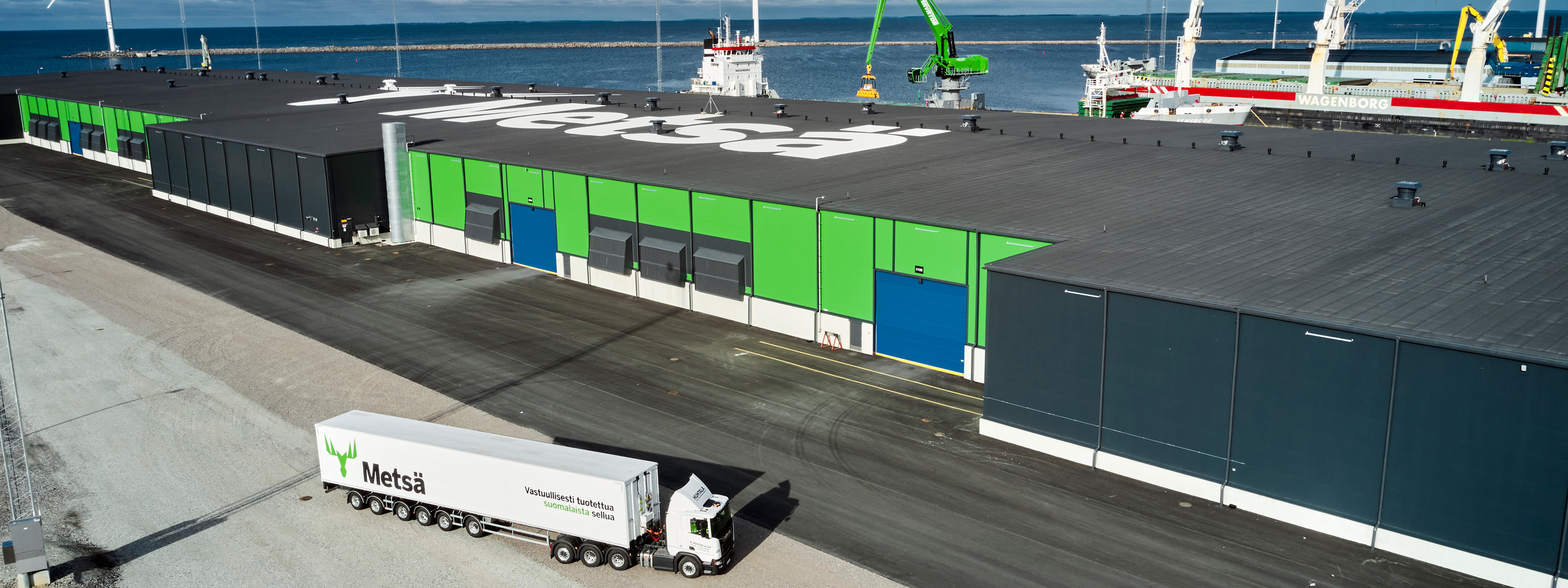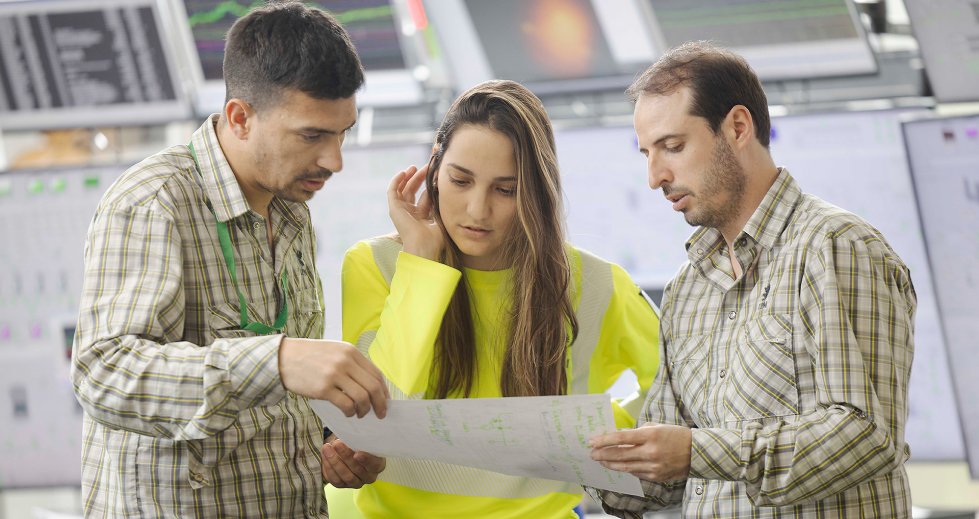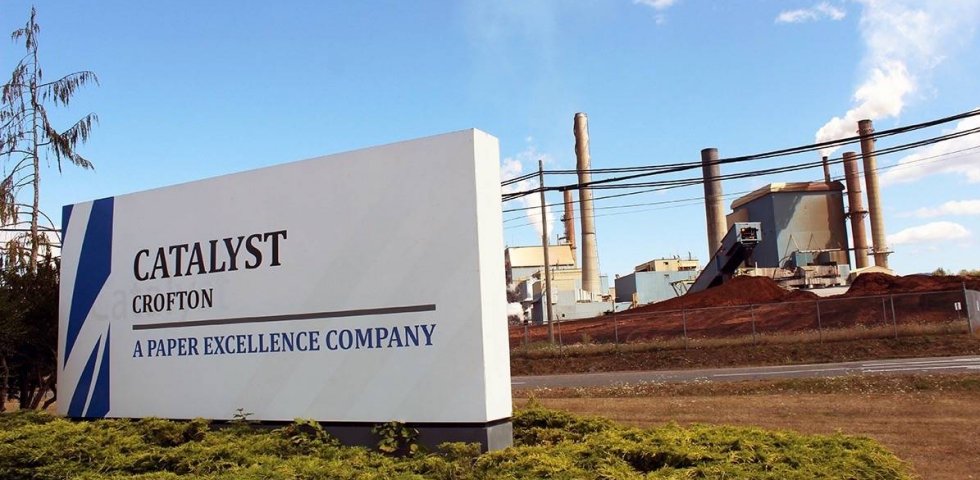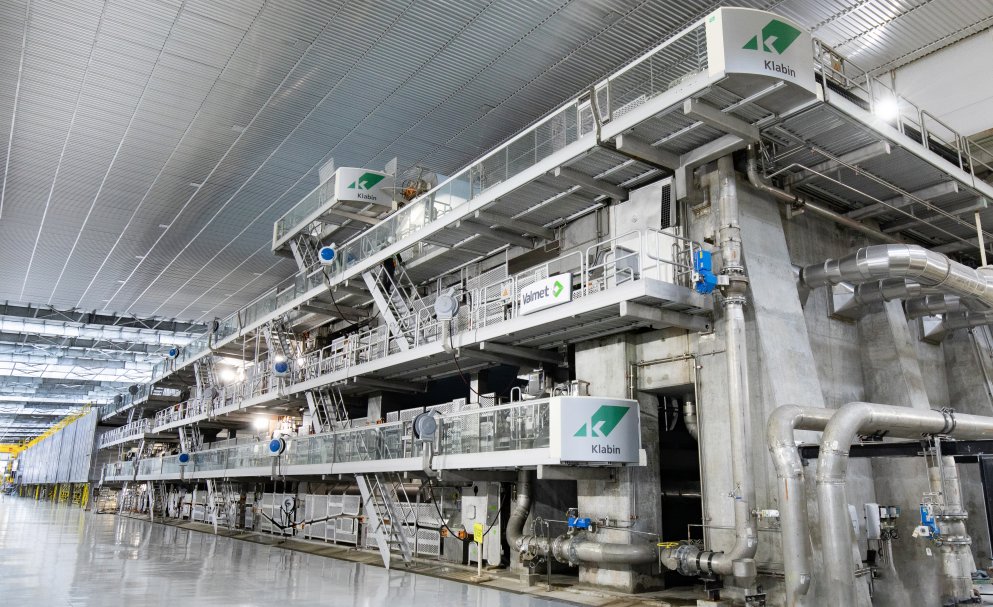|

Metsä Group's Kemi Bioproduct Mill Ensures Efficient Logistics
Feb. 26, 2024 - In response to the needs of Metsä Group's new bioproduct mill in Kemi, an efficient and reliable logistics solution has been developed, taking into account sustainability at every stage of operation and minimizing environmental impacts.
Pulp bales produced at the bioproduct mill are automatically loaded onto HCT (High Capacity Transport) trucks. These trucks, powered by biodiesel, transport the bales to a port warehouse located 15 kilometers away. The specially designed HCT truck can carry approximately 72 tons of pulp load at once, about 1.5 times more than a standard truck load. These solutions significantly reduce the carbon footprint of transportation.
A new logistics route, built in collaboration with the city of Kemi, enhances transportation and traffic safety in the area.
At the Ajos port, pulp bales are directed to Metsä Group's new 37,000 square meter product warehouse, where unloading is automated. Fossil fuels in the port and warehouse have been replaced with electrified forklift and loading equipment. Additionally, the port's electronic material handling crane features an electronic pulp grab, the first of its kind.
Eight new electric forklifts at the port improve environmental efficiency and enhance workplace safety. The elevated cabin, improved visibility, and lower noise levels contribute to a safer working environment.
For pulp shipments to Asian markets, the mill uses the latest vessel fleet where the technology enhances environmental efficiency.
"The foundation of the new logistics solution is to ensure safety, delivery reliability, and environmental efficiency. It secures a smooth chain from the mill to customers," says Pasi Pulkkinen, who was the Logistics Director for the Kemi bioproduct mill project.
"The core process of port operations remains the same as before, but with the latest equipment investments, the opportunities to improve operations in every aspect have grown significantly," explains Teemu Kauppi, Director of Kemi Port Operations unit. With the new bioproduct mill, the export from Ajos port in Kemi abroad is expected to increase by over a million tons annually.
SOURCE: Metsä Group |
|

UPM Pulp’s Regular Customer Surveys Provide Valuable Input for Development of Services
By Timo Nykänen for UPM Pulp
Nov. 9, 2023 - Through customer surveys, UPM Pulp is able to deepen its knowledge of customer attitudes, thoughts and perceptions. Surveys have provided valuable insights to help further improve the company’s standards of excellence and offer a tool for continuous development that brings an external customer dimension to performance management.
 UPM Pulp conducts a survey twice a year to measure customer satisfaction. The survey has been carried out in its current form for three years and this is sent out to around 500 customer contacts. According to Miikka Kangas, Senior Manager Commercial Development, Pulp Sales at UPM Pulp, the aim has been to keep the survey light and simple, with only two main questions. The first of these refers to the global NPS (Net Promoter Score) metric, allowing for industry benchmarking and providing a target for development. UPM Pulp conducts a survey twice a year to measure customer satisfaction. The survey has been carried out in its current form for three years and this is sent out to around 500 customer contacts. According to Miikka Kangas, Senior Manager Commercial Development, Pulp Sales at UPM Pulp, the aim has been to keep the survey light and simple, with only two main questions. The first of these refers to the global NPS (Net Promoter Score) metric, allowing for industry benchmarking and providing a target for development.
“We ask customers how likely they are to recommend UPM Pulp to their friends or colleagues, and how well they consider us to have performed compared to the pulp industry in general with regards to certain criteria. These include pulp quality and service, handling exceptional situations, and listening to and understanding customers,” Kangas explains.
The latest NPS score was 46, comparing well to the benchmark average of 39. However, UPM has set a target NPS score of 53, which would place the company in the top 25% within the industry.
Combining General Satisfaction and Topical Issues
Although the survey is mainly a “happy or not” type of questionnaire, additional feedback can be provided to open questions on how, in the customer’s view, UPM Pulp could improve on each of these issues. According to Kangas, one of the most common topics touched upon in open comments is the need for more communication, which he admits is something where you can never have too much. The survey also includes a region-specific question that may vary between surveys.
“In the latest survey carried out between October and November 2023, we asked customers in Europe about their experiences concerning the performance of our customer service, while in the APAC region the additional question concerned the digitalisation of services and solutions. Perhaps an upcoming question could be related to the ramp-up period of our Paso de los Toros mill and how we have lived up to customer expectations concerning communication of the different phases,” Kangas says.
Follow-up in Dedicated Customer Teams
Run for about two weeks in more than 20 languages, the survey typically reaches a response rate of around 30-40%. The NPS score measuring customer loyalty has remained at a stable level – with the notable exception of a drop in the curve in 2022, when UPM suffered from industrial action in Finland.
 “This was a completely understandable reaction, but we luckily recovered from the situation rather swiftly. This was reflected in very few mentions in open comments in the following survey after resuming normal operations,” says Tomas Wiklund, Senior Vice President, Pulp Sales at UPM Pulp. “This was a completely understandable reaction, but we luckily recovered from the situation rather swiftly. This was reflected in very few mentions in open comments in the following survey after resuming normal operations,” says Tomas Wiklund, Senior Vice President, Pulp Sales at UPM Pulp.
Wiklund emphasises the importance of the survey in the constant development of UPM Pulp’s offering, as the feedback is not anonymous, and can thus be responded to promptly and precisely. UPM Pulp’s external research partner provides analysis and conclusions on the survey results, which are examined on both a global and regional level. Analysis is also carried out in customer teams, and corrective actions are taken where necessary.
“Our customer teams follow the results according to each customer and see if we have managed to follow the path of continuous improvement, or if there is some issue that stands out and requires addressing immediately,” Wiklund notes.
Feedback Makes a Difference
Considering the attributes that customers value most, quality takes the top spot with a clear margin, followed by customer service then reliability in third place. According to Kangas, a positive signal is also that around half of the respondents are regular participants in the survey and they are committed to delivering feedback repeatedly.
“I would like to thank all our customers for their active participation and urge everyone who hasn’t yet responded to take part in our next survey. Your feedback is extremely valuable to us and truly makes a difference in further strengthening our cooperation,” Wiklund concludes.
SOURCE: UPM Pulp |
|

Paper Excellence Canada Restarts Pulp Operations at Catalyst Crofton Mill
Sept. 27, 2023 - Paper Excellence Canada announced the resumption of kraft pulp operations at its Catalyst Crofton mill, bringing more than 300 workers back to their jobs.
"While market conditions allow for the restart of our pulp operations, the curtailment of paper operations at Crofton is being extended to the end of October," the company said in a press release.
Krista Cuddy, Catalyst Crofton, Interim Director - Operations & Integration, explained, "In spite of challenges posed by exceptionally low pulp and paper prices driven by global market fluctuations, we are pleased to announce that we are resuming pulp production and reinstating a portion of our workforce at our Crofton mill. While this is a positive development, we will continue to assess the ongoing viability of maintaining Kraft pulp operations at Crofton to ensure it is cost effective to operate and consistent with our overall business strategies."
Paper Excellence Canada continues to work with both the Public and Private Workers of Canada (PPWC) and Unifor unions to support our valued workforce as we restart pulp production and mitigate the impact of the ongoing paper production curtailment.
Catalyst Crofton Mill
Located on Vancouver Island, Crofton, British Columbia, the Crofton Mill has two paper machines and two pulp lines. The mill has the capacity to produce 320,000 tonnes per year of printing / packaging papers and 380,000 tpy of NBSK pulp.
Paper Excellence Canada, headquartered in British Columbia, is a diversified manufacturer of pulp and specialty, printing, writing, and packaging papers in Canada with a production capacity of over 2.5 million tonnes annually.
SOURCE: Paper Excellence Canada |
|

Klabin Holds Inauguration Ceremony for Puma II in Paraná, Brazil
Sept. 26, 2023 - Klabin on Sept. 21 held an inauguration ceremony for its Puma II — a project that marked the expansion of the Puma Unit in Ortigueira, Paraná, Brazil.
According to Klabin, the Puma II project is the largest investment in the company's history and the largest private investment ever made in the State of Paraná. With an investment of R$12.9 billion, Klabin installed two new paper machines — MP27 and MP28 — which are both in operation and have a combined production capacity of 910 thousand tons per year of packaging paper grades.
The inauguration was attended by members of the board of directors, management and employees of Klabin, customers, suppliers, business partners, communities, press and authorities. The Governor of the State of Paraná, Ratinho Junior, and the Mayor of Ortigueira, Ary Mattos, as well as local authorities, attended the ceremony, which began with a guided tour of the new machines.
Puma II Project
Announced in 2019, the Puma II Project is part of Klabin's biggest growth cycle in its 124-year history. The first phase, completed in August 2021, included the construction and start-up of Paper Machine 27 (MP27), which manufactures the innovative Eukaliner®, the world's first kraftliner paper made 100% with eucalyptus fiber.
Two years later, in June this year, there was the startup of the Paper Machine 28 (MP28), the second of the Project, which focuses on the production of paperboard. The equipment also symbolizes Klabin's debut in the white paperboard market, reinforcing the expansion of its product portfolio.
Together, the two machines increase Klabin's annual production capacity to 4.7 million tons of paper and cellulose.
“Conceived more than ten years ago, with the construction of the Puma Unit, between 2013 and 2016, the completion of the Puma II Project marks a new decade of growth for Klabin,” said Francisco Razzolini, director of Industrial Technology, Innovation, Sustainability and Projects at Klabin. “We significantly increased our production capacity, entered new markets and employed cutting-edge technology to raise the quality of our products and boost the company's sustainable development.”
Regionally, the two phases of the Puma II Project generated more than 33 thousand direct and indirect jobs. In addition to encouraging partner companies to hire local workers, Klabin also valued labor by investing in technical training in the communities of Ortigueira and Telêmaco Borba, in Paraná.
Between 2013 and 2023, the Puma Unit received the largest investments in Klabin's history, adding 2.5 million tons per year to the company's total production volume.
Sustainable Production
For the Puma II, the company invested in a series of initiatives that use innovation as a sustainability lever, such as the biomass gasification plant project, which allows one of the factory's lime kilns to operate 100% fossil fuel-free, reducing greenhouse gas emissions. In this sense, currently, 98% of the waste generated in the operation of Puma II is reused.
In another example, the innovative potassium sulfate plant treats ash generated in the recovery boiler that results in a substance used in the formulation of fertilizers.
Currently, the Puma II unit has 96% renewable fuels in its energy matrix. There is also a sludge drying plant, responsible for processing biological and tertiary sludge generated at the plant's effluent treatment stations. Klabin noted that with a capacity of up to 17 thousand tons/month, this will be the first system in the world to dry sludge generated in tertiary effluent treatment. The dry sludge can be mixed with biomass to become fuel for the power boilers.
Logistics in Paraná
In parallel to the development of the Puma II Project, Klabin set up a robust logistics operation in order to facilitate the flow of production for export. Next to the Ortigueira factory, a container terminal was built for road and rail transport with the capacity to transport 125 thousand tons of cellulose and paper in containers per month to the Port of Paranaguá in Paraná.
In addition, the company also began operations at the Klabin Port Terminal (PAR-01), located on the commercial pier of the Port of Paranaguá. With the capacity to receive one million tons of cellulose and paper per year, PAR-01 is part of the logistics investment package made by Klabin in the State in recent years. The operation consolidates Klabin's logistics strategy in Paraná, bringing even more competitiveness, flexibility and sustainability and guarantees excellent logistics between forest, factory and port.
With the completion of the second phase of Puma II, Klabin estimates it will move 2.2 million tons of paper and cellulose per year via Paranaguá.
SOURCE: Klabin |
|
|